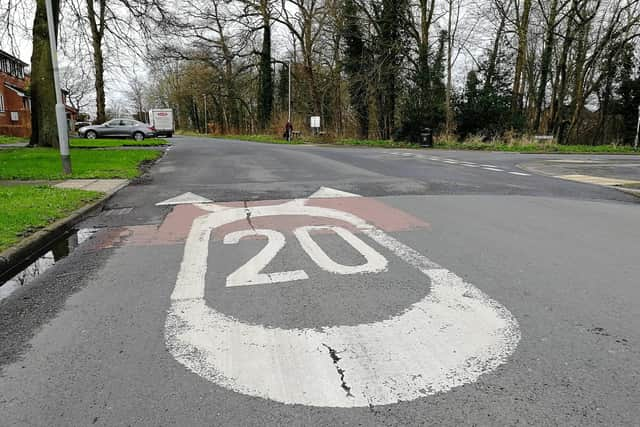Lancashire’s roads to get 20mph limits only where they are ‘necessary and wanted’
and live on Freeview channel 276
Lancashire County Council has made the commitment by agreeing to incorporate the government’s ‘Plan for Drivers’ into its own highway policies.
However, the move has drawn criticism from opposition councillors who say it calls into question the use of the lower limit - even though it can be a lifesaver.


Advertisement
Hide AdAdvertisement
Hide AdThe nationwide plan, which was unveiled in October, sets out 30 measures that ministers say will stop drivers feeling as though they are “under attack”. They include setting the “right speed limits in the right places” and, specifically, updating guidance on 20mph zones in order “to help prevent inappropriate blanket use”.
“We will make it clear that 20mph speed limits in England must be used appropriately where people want them,” transport secretary Mark Harper said at the launch of the document.
At a meeting shortly before Christmas, the Conservative-run county council welcomed the plan as a whole and pledged to integrate it so that “[the] benefits are maximised for Lancashire residents".
Since 2011, County Hall has rolled out 20mph limits on what it describes as “main residential areas and outside schools”, but “not on major through-routes, so traffic can keep moving efficiently”.
Advertisement
Hide AdAdvertisement
Hide AdProposing a motion backing the Plan for Drivers - which also includes stopping “unfair enforcement” of traffic offences and making it easier to challenge “unfair parking rules” - Tory County Cllr Ash Sutcliffe said it was a matter of “balance”.
“Anyone who lives in Lancashire knows its diversity of terrain and…transport opportunities. [Some] Lancashire residents rely on their cars for freedom owing to their rural location.
“Recognising that our cities, towns and villages are all fundamentally different is important. The Plan for Drivers is not the opposite of the ambitions around active travel [cycling and walking] - it is designed to complement and enhance [them].
“I’m personally not in favour of blanket 20mph zones - and we’ve said it’s always about where they are appropriate,” County Cllr Sutcliffe said.
Advertisement
Hide AdAdvertisement
Hide AdHowever, Labour’s John Fillis blasted the government for suggesting that 20mph roads are “a problem for drivers”.
“If a driver can’t stay within the speed limit, then I say it's the driver who is the problem, not 20mph roads,” County Cllr Fillis said.
He also criticised any suggestion that Whitehall could dictate the speeds driven on Lancashire's highways.
“Is it hard-working councillors, working with their communities and the police, [who should] identify which roads should be 20mph - or a dead duck prime minister in London?” the former deputy Labour group leader asked.
Advertisement
Hide AdAdvertisement
Hide AdHis party colleague Steve Holgate described it as "absolute nonsense” to suggest that 20mph limits hindered motorists.
“Driving 20 mph through a town [or] a busy village or...near a school is not that difficult. Just put it in second gear - [these are] basic driving skills. 20mph is the way in which we reduce deaths on the road,” County Cllr Holgate added.
The motion did not call for the reversal of any existing 20mph limits and, in response to a separate question on their enforcement, cabinet member for highways and transport Rupert Swarbrick had said that the longstanding implementation of the lower speed in residential locations was born out of “clear evidence that, in those areas, a reduced speed limit does save lives”.
“Judging by the demand for ‘Slow down, save lives’ bin stickers…our view is that the 20mph speed limit works where it is appropriate [and] where there is community support,” County Cllr Swarbrick explained.
MORE HERE >» Lancashire roads boss says there will be no "blanket" 20mph speed limit in the county .
Advertisement
Hide AdAdvertisement
Hide AdMeanwhile, Green Party group leader Gina Dowding took issue with both the specifics and principle of the Plan for Drivers, describing it as “a desperate attempt [by Rishi Sunak] to steer a few voters his way by using car driving to divide people”.
The plan promises “consistency” on the issuing of traffic fines and to consider “restrict[ing] local authorities’ ability to generate surpluses from traffic offences and overzealous use of traffic enforcement powers”. However, County Cllr Dowding told the meeting that most people wanted better enforcement - not less.
“We don't want people parking on yellow lines, blocking corners, blocking visibility - [and] we don't want more people getting away with speeding.
“Thirteen years of Tory policies and underinvestment in public transport…has forced so many people to use cars. But we’re not all car drivers and we're not only car drivers - we are public transports users, cyclists…and walkers and many of us use different forms of transport at various times,” said County Cllr Dowding, adding that almost a quarter of people in her Lancaster district do not even have access to a motor vehicle.
Advertisement
Hide AdAdvertisement
Hide AdA Labour amendment to the Conservative motion - calling for the county council to protect current 20mph routes in Lancashire - was defeated.
Speed limits became a touchstone political issue nationally after Wales made 20mph the default limit for its residential roads last year - while leaving local authorities the flexibility to decide which routes should remain at 30mph. It was expected that the move would increase the proportion of Welsh roads with a 20mph limit from just 2.5 percent to around 35 percent.